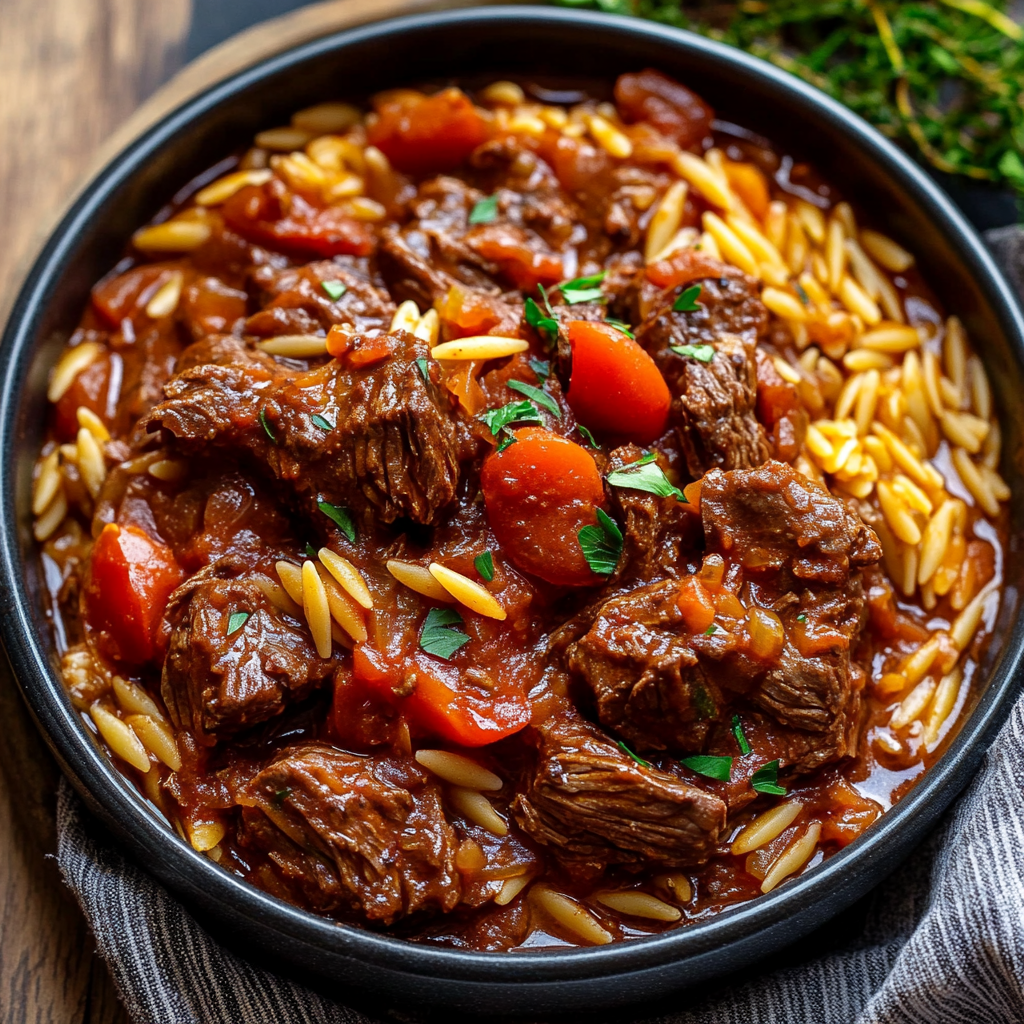Beef Giouvetsi is a traditional Greek dish that brings together tender braised beef, aromatic spices, and orzo pasta in a rich tomato sauce. The slow cooking process ensures that the beef becomes melt-in-your-mouth tender, while the spices infuse the sauce with warmth and depth. This one-pot wonder is perfect for family dinners or cozy gatherings, offering a taste of Greece in every bite.
Whether you’re familiar with Greek cuisine or new to it, Beef Giouvetsi offers a delightful culinary experience. The combination of tender beef, savory tomato sauce, and al dente orzo pasta creates a comforting and satisfying meal. Serve it with a sprinkle of grated cheese and a side of crusty bread to soak up the delicious sauce. It’s a dish that will surely become a favorite in your household.
Full Recipe
Ingredients:
-
2 tablespoons olive oil
-
1 pound beef (such as chuck), cut into bite-sized cubes
-
Salt and pepper to taste
-
1 onion, diced
-
1 carrot, shredded (optional)
-
3 cloves garlic, chopped
-
3 tablespoons tomato paste
-
1/4 cup red wine (or beef broth)
-
3 cups beef broth (or chicken broth, or vegetable broth)
-
1 (14.5 ounce) can tomatoes, crushed with hands
-
1/2 teaspoon cinnamon
-
1/4 teaspoon allspice
-
1/4 teaspoon nutmeg
-
2 dried bay leaves
-
1 cup orzo pasta (gluten-free for gluten-free)
Directions:
-
Heat the oil in a large oven-safe pan over medium-high heat. Add the beef, seasoned with salt and pepper, and brown, about 2-4 minutes per side. Remove and set aside.
-
Add the onion and cook until tender, about 5 minutes.
-
Add the carrot and cook for a minute.
-
Add the garlic and tomato paste, mix and cook for a minute.
-
Add the wine and deglaze the pan, scraping up any browned bits off the bottom of the pan with a wooden spoon.
-
Add the broth, tomatoes, cinnamon, allspice, nutmeg, bay leaves, and beef. Mix and bring to a boil. Reduce the heat to low and simmer, covered, until the beef is falling apart tender, about 2-4 hours.
-
Mix in the orzo and cook until the orzo is tender, about 10 minutes.
-
Remove the bay leaves and enjoy!
Prep Time: 10 minutes
Cooking Time: 3 hours 30 minutes
Total Time: 3 hours 40 minutes
Kcal: 391 kcal
Servings: 4
Introduction to Beef Giouvetsi
Beef Giouvetsi is a beloved dish in Greek cuisine that embodies the very heart of Mediterranean comfort food. Known for its tender chunks of beef slow-braised in a rich tomato sauce and finished with orzo pasta, this one-pot meal is deeply flavorful and satisfying. The name “Giouvetsi” refers to the traditional clay pot in which this dish was often prepared, though it can be easily made in any oven-safe pot or Dutch oven.
This dish is traditionally served at Sunday family dinners and festive occasions in Greece, and it showcases the Greek passion for slow cooking, spices, and the art of balancing textures. Unlike pasta dishes in other Mediterranean cultures, Greek pasta recipes like this one take on a stew-like consistency, where the starch from the orzo thickens the sauce to a creamy, risotto-style finish. It’s a meal that brings together simplicity and depth, rustic charm and culinary finesse.
The History Behind the Dish
Giouvetsi (sometimes spelled “Youvetsi” or “Yuvetsi”) has its roots in traditional Greek and Byzantine cooking. The use of cinnamon, allspice, and nutmeg in savory meat dishes traces back to a time when spice trade influenced the Mediterranean basin. These spices were not just about flavor—they were believed to warm the body and promote health, especially during colder months.
The original method of making Giouvetsi involved slow baking the meat and pasta in a clay vessel in a communal village oven. This ensured even heat and allowed the flavors to develop gradually, often over several hours. Today, while home ovens have replaced communal ones, the recipe has retained its authenticity and remains largely unchanged, which is a testament to its timeless appeal.
Why Beef Giouvetsi Stands Out
There are a few defining elements that make Beef Giouvetsi truly unique. The first is the quality and cut of beef used. Typically, tougher cuts such as chuck or shoulder are chosen, which are ideal for slow braising. As the meat simmers over low heat, it breaks down and becomes fork-tender, infusing the sauce with deep, meaty flavor.
Another hallmark is the orzo—small, rice-shaped pasta that absorbs the tomato and beef juices during the final stage of cooking. Unlike boiling pasta separately, the orzo is cooked directly in the sauce, which not only enhances its flavor but also thickens the entire dish into a rich, cohesive stew.
Then there’s the signature Greek spice blend. A subtle mix of cinnamon, allspice, and nutmeg adds warmth and complexity to the tomato-based sauce. These spices might be more commonly associated with desserts in Western cuisine, but in Greece, they are integral to savory dishes like Giouvetsi and Moussaka, offering a unique depth that’s both aromatic and comforting.
Regional and Family Variations
As with most traditional dishes, Giouvetsi has several regional and family variations. Some versions use lamb instead of beef, particularly in the Cyclades and other island regions, where lamb is more common. Chicken can also be used for a lighter take.
In northern Greece, red wine is often added to the sauce for extra depth, while some southern versions incorporate cinnamon sticks instead of ground cinnamon for a milder flavor. Others may add a pinch of sugar to balance the acidity of the tomatoes.
Cheese is another variable component. Many Greeks like to serve their Giouvetsi with a generous grating of Kefalotyri or Mizithra cheese on top. These salty, tangy cheeses add richness and contrast to the mellow, tomato-based stew. In some households, feta is crumbled over the top before serving, offering a creamy and slightly tangy counterpoint.
Cultural Significance and Occasions
Beef Giouvetsi isn’t just a meal—it’s a cultural touchstone. In Greece, it symbolizes home-cooked warmth, family gatherings, and shared tables. It’s a favorite for Sunday dinners, religious holidays, and celebratory feasts. The act of preparing Giouvetsi—slow, deliberate, and full of care—mirrors the Greek philosophy of enjoying life and taking time for what matters most.
This dish also tells a story of culinary continuity. In an era where fast food dominates, Giouvetsi reminds us of the value of patience and tradition. It encourages cooks to slow down, engage with each ingredient, and let flavors build over time.
Tips for Perfecting Beef Giouvetsi at Home
While Giouvetsi is simple in ingredients, mastering its technique can take it from good to exceptional. One important tip is to brown the beef well before braising. This caramelizes the exterior and locks in juices while contributing to a deeper flavor base.
Deglazing the pot with red wine not only lifts those browned bits from the bottom but also introduces acidity and depth that balances the richness of the meat. If you don’t cook with wine, beef broth with a splash of balsamic vinegar makes a worthy substitute.
When cooking the orzo, it’s essential to monitor the liquid level. Orzo absorbs liquid quickly, and without enough broth or sauce, it can dry out or stick. Stirring occasionally while it cooks helps prevent clumping and ensures an even, risotto-like texture.
Lastly, resting the dish before serving allows the flavors to settle and the sauce to thicken naturally. Some home cooks even say Giouvetsi tastes better the next day, once the orzo has absorbed more of the savory sauce overnight.
Pairing and Serving Suggestions
Beef Giouvetsi pairs beautifully with a range of accompaniments. A crisp Greek salad with cucumbers, tomatoes, olives, and a tangy feta dressing provides a refreshing contrast to the richness of the stew. Crusty bread is practically a requirement—to scoop up every bit of sauce left on the plate.
For wine lovers, a full-bodied red like a Xinomavro or Agiorgitiko from Greece complements the dish’s earthy spices and beefy depth. A dry red from Italy or France, such as Chianti or Syrah, also works well.
To finish the meal, consider a simple Greek dessert like Galaktoboureko (custard pie) or a piece of honey-drenched baklava to complete the traditional experience.
Nutritional Notes and Adaptations
Beef Giouvetsi is naturally high in protein and carbs, making it a filling and satisfying dish. While it’s not low in calories, it’s certainly balanced and nutritious when served with vegetables or a salad.
For gluten-free adaptations, gluten-free orzo made from rice or corn flour is a great alternative. The dish also works well with plant-based meat alternatives or even mushrooms for a vegetarian twist. Replacing the beef with lentils and using vegetable broth creates a hearty vegetarian version that still honors the original’s rich flavor.
Why You Should Make It Tonight
There’s something magical about meals that bring people together, and Beef Giouvetsi is one of those dishes. It’s soulful, easy to prepare in advance, and makes your home smell incredible while it cooks. It’s also versatile enough to be a centerpiece for both everyday dinners and special gatherings.
What makes Giouvetsi stand out isn’t just its taste—though it’s absolutely delicious—but the experience it offers. It invites you to slow down, cook with love, and savor every spoonful. It’s comfort food at its finest, grounded in tradition but flexible enough for modern kitchens.
Conclusion
Beef Giouvetsi is much more than just beef and pasta. It’s a story passed down through generations, a culinary link between the past and the present. With its warm spices, tender meat, and rich tomato base, this Greek classic offers both simplicity and sophistication in one humble pot.
Making Beef Giouvetsi connects you with centuries of Greek tradition, celebrating a way of cooking that’s deliberate, hearty, and filled with soul. Whether you’re new to Greek cuisine or looking to deepen your love for Mediterranean flavors, this dish is a must-try. Once you experience its deep flavors and comforting textures, it’s likely to become a cherished addition to your recipe collection.






